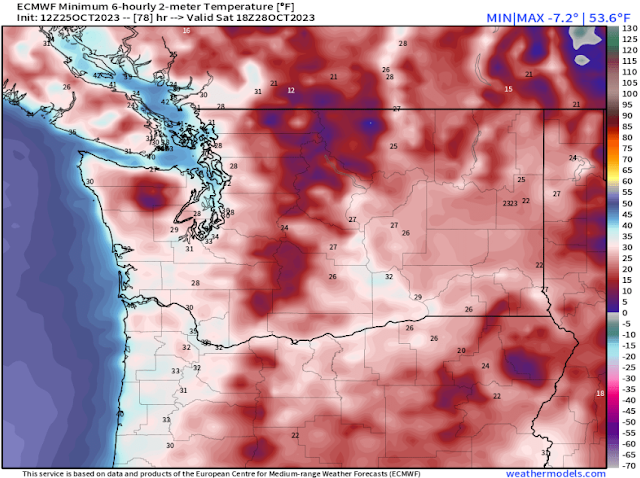FastCast--Tuesday, Oct. 31 to Friday, Nov. 3:
After a consistent sunny, dry, and cold pattern, a significant shift is ahead. First off, expect dry conditions with a near-zero chance of rain during peak trick-or-treating times on Halloween. Conditions across the lowlands will be partly cloudy, with temperatures in the low to mid 40s, so bundle up! A noticeable temperature increase is expected over the coming days, with lows in the low to mid 30s one more time on Tuesday morning before high clouds increase and highs reach the mid 50s. Wednesday will be cooler, with thick cloud cover and highs only reaching the upper 40s to low 50s. Subtropical air related to the major pattern change will bring highs on Thursday and Friday to the upper 50s to low 60s. Lows will reach the upper 30s to low 40s on Wednesday morning, but will substantially increase to the upper 40s to low 50s on Thursday and Friday mornings. The pattern will change with a bang, as an atmospheric river moves into the Northwest, bringing significant rain to the lowlands from late Wednesday through early Friday. Forecast models still have some disagreement about rainfall amounts, with the European model suggesting 1-2" for the lowlands and the GFS (American) model suggesting 0.5-1.5", but most from Seattle south. Both forecasts show around 1-1.5" for the metro area within a 36-hour period, which will bring areas of standing water and urban flooding. Additionally, winds will gust 30-40 mph for the North Sound, strongest near the water. Stay tuned over the coming days as details get clearer on this atmospheric river and future storms.
------------------------------------------------------------
Continue reading the full blog below!
The stormiest month of the year will likely begin with an atmospheric river and a pattern change to a wet and stormy pattern, replacing the high pressure and consistent sunny days with frosty mornings. Let's take a look at the forecast!
We'll start with the European model forecast showing water vapor in the atmosphere late Wednesday night. The atmospheric river is clear, aimed at the Northwest.
This is the classic signature of an atmospheric river, sometimes called a "Pineapple Express" in the Northwest. You can see why this moniker was coined, since the plume of moisture (atmospheric river) originates in the region of Hawaii (bottom left of map).
Let's compare this forecast to the UW WRF forecast, also showing water vapor in the atmosphere late Wednesday night.
The UW WRF model agrees with the European in showing an atmospheric river slamming the Northwest. However, the UW WRF shows this atmospheric river going a bit further south than the European forecast. This model typically aligns with the GFS (American) forecast, which currently shows the atmospheric river aimed south of the European model forecast.
Let's compare precipitation totals between the European and GFS models, starting with the European model, showing total rain through Friday morning.
The European model shows this atmospheric river slamming Western Washington. This forecast gives the lowlands 1-2" of rain, with up to 2.5" from Arlington northward. The coast gets 1.5-3", with the Cascades and Olympics picking up 3-5". Even Eastern Washington gets 0.3-0.5", with areas closer to the Idaho border, such as Spokane and Pullman, getting 0.6 to 1".
Let's take a look at the GFS forecast, also showing rain through Friday morning.
Notice the differences? The GFS forecast shows significantly less rain, with the lowlands picking up 0.5-1.4". This forecast has a prominent rain shadow over the NE Olympic Peninsula, with Everett and Mount Vernon getting around 0.4-0.6". Areas from Seattle south to the Central Willamette Valley (including the coast and mountains) would likely get 0.8-1.5" with this forecast. The heaviest precipitation is roughly south of a line from Salem to Lincoln City, where 2-3" is possible.
Regardless of the difference in forecasts, moderate to heavy rain at times is likely for the entire region between late Wednesday night and early Friday morning. Below is the NWS Weather Prediction Center Excessive Rainfall Outlook for Wednesday to Thursday morning.
The WPC is highlighting a marginal risk of excessive rainfall over Western Washington and extreme NW Oregon. This is due to the threat of standing water, ponding, and urban/small stream flooding because this atmospheric river will bring all its rain within 36 hours.
Forecasts will likely change over the next couple days. The next blog post will be on Wednesday night, as rain is beginning for the region. Stay tuned for that post, which will be an update on the atmospheric river and what to expect.
We will wrap up tonight's blog with a look at the European EPS forecast for 24-hour rain in the Seattle area.























































